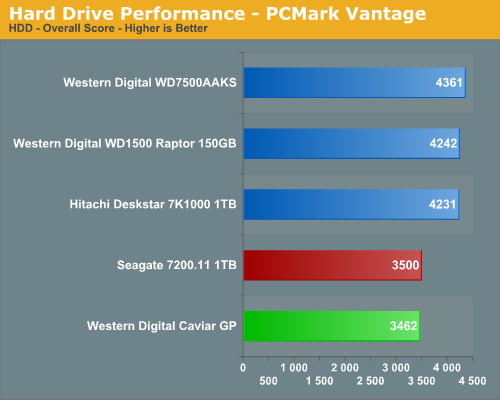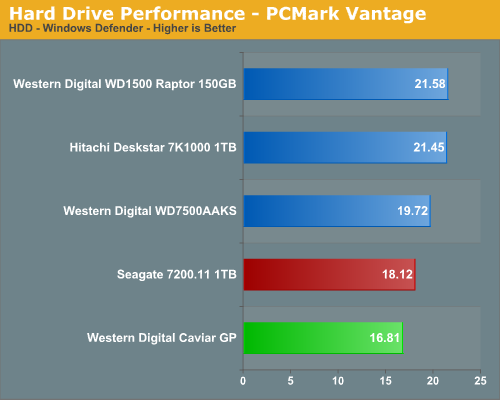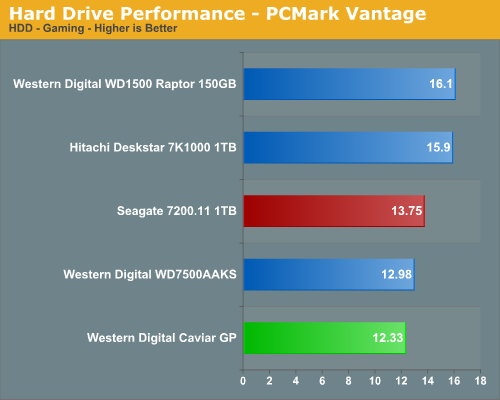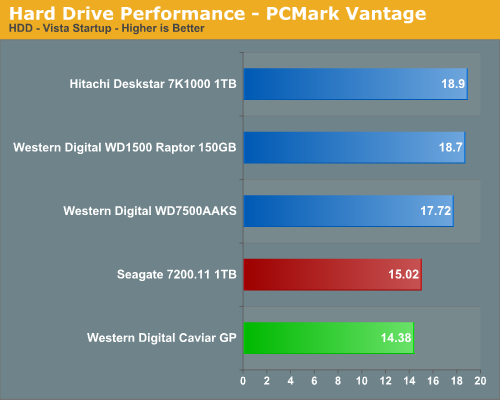Seagate and Western Digital 1TB Drives: Improved and Green
by Dave Robinet on November 26, 2007 7:00 AM EST- Posted in
- Storage
Windows Vista
Vista (and its associated drivers and applications) has finally matured to the point where we feel comfortable including it in our benchmark suite. To that end, we are pleased to include the following as our inaugural Vista storage selections:
- Windows Vista Startup / Shutdown
- PCMark Vantage
Going forward, we will continue to expand the Vista benchmark and application selection as they become ready for prime time. With this in mind, we have chosen not to include hibernation benchmarks in our initial round of testing due to related issues with Vista. Service Pack 1 should go a long way towards resolving these issues (and initial looks at the latest release candidate suggest that it does), so we will revisit this decision when the final release of SP1 comes out.
Our Vista strategy follows the one we are using for Windows XP. We apply only major milestone releases (SP1, SP2, etc) and keep drivers updated as necessary. Whenever there is a major driver (or OS) update, we will go back and re-run previous benchmarks to ensure that the data set remains consistent. For our tests, we disable Windows Defender, set the paging file to a static 3.0GB in size, and limit the Recycle Bin to 1GB maximum. We also close the Sidebar application.
PCMark Vantage
PCMark Vantage is the latest benchmark available from Futuremark, and is available only on Windows Vista. Similar to the venerable PCMark05 in its makeup, Vantage modernizes the criteria and test methodology to reflect what users may encounter when running the new Windows OS.
For the HD test suite, the white paper breaks the tests down as:
- Windows Defender: Windows Defender performs a scan operation, resulting in a read-intensive (99.5% read, 0.5% write) benchmark reflecting a common task in Windows Vista.
- Gaming Performance: Streaming performance is measured using actual game mechanics found in Alan Wake. This test is nearly all read (99.95% read, 0.05% write) in nature.
- Windows Photo Gallery: A large collection of images is imported into Windows Photo Gallery. This is the first of the tests which bring write performance into account in a meaningful way, with a roughly 84% read, 16% write ratio.
- Windows Vista Startup: Simulates Windows Vista start-up operations, producing a test that breaks down to roughly 85% read and 15% write operations.
- Windows Movie Maker: The first of the Vantage tests which comes close to equally dividing read and write operations (54% read, 46% write), concurrent video performance is tested both for video read and skip performance, as well as video write operations.
- Windows
Media Center: Performing three distinct tasks:
- SDTV video playback
- SDTV video streaming to Extender for Windows Media Center
- SDTV video recording
- Windows Media Player: Adds music to Windows Media Player. This test reverts to favoring read operations (78% read, 22% write).
- Application
Loading: The following applications are loaded:
- Microsoft Word 2007
- Adobe Photoshop CS2
- Internet Explorer 7
- Outlook 2007
The total benchmark is roughly 87% reads and 13% writes in nature. We run each test five times per drive, producing a median score that we use for comparison in our charts.















31 Comments
View All Comments
Luminair - Tuesday, November 27, 2007 - link
"Operating System Stated Capacity"Lets be clear so maybe you can be clear in the next article.
The IEC, IEEE, CPIM, and NIST define Giga (G) as 1,000,000,000 or one billion.
The same standards organizations define Gibi (Gi) as 1,073,741,824.
As such, by standard definitions, these hard drives are in fact 1000GB, or 1000 gigabytes.
Your "Operating System Stated Capacity" really means "Windows Explorer Capacity". Other operating systems don't get it wrong like Windows does. So if you report this wrong information at all, you should make the truth known -- that Windows is well known to WRONGLY report GiB as GB (and MiB for MB and so on).
Those drives have 1000 gigabytes of space. Windows Explorer and solid state memory companies report the space incorrectly.
Luminair - Friday, November 30, 2007 - link
These guys get it right :) http://www.pcgameshardware.de/?menu=browser&ar...">http://www.pcgameshardware.de/?menu=bro...&ima...valherumk2 - Tuesday, November 27, 2007 - link
Looks like another review of the 7200.11 drive where it appears the reviewer didn't remove the jumper limiting it to SATA 1. Interface bandwidth burst rate is over 200MB/s on my 7200.11 with the jumper removed.Zap - Thursday, November 29, 2007 - link
That's also the first thing that came to my mine... "dude forgot to remove the jumper."Zap - Thursday, November 29, 2007 - link
That's also the first thing that came to my mine... "dude forgot to remove the jumper."100proof - Monday, November 26, 2007 - link
Dave, is there a reason that Samsung's 1TB drivewas not included in this review? The drive is
difficult to obtain in the US but is available in
other countries at this point in time. Tomshardware
has already posted a review, and there is also
discussion taking place on storagereview.com
Tomshardware Review of Samsung F1 1TB
http://www.tomshardware.com/2007/11/21/samsung_ove...">http://www.tomshardware.com/2007/11/21/samsung_ove...
Storagereview discussion of F1 Series
http://forums.storagereview.net/index.php?showtopi...">http://forums.storagereview.net/index.php?showtopi...
Dave Robinet - Tuesday, November 27, 2007 - link
It's a matter of availability, not of lack of interest. We do like the latest Samsung offerings - they simply didn't have a drive shipped to us in the lab in time for the article.If they get us a 1TB drive for us to have a look at, then we'll gladly put it in a future article.
Thanks for reading!
quanta - Wednesday, November 28, 2007 - link
In the meantime, Tom's hardware did the Samsung Spinpoint F1 review[1], which showed it has great non-server performance. In fact, it outruns WD Raptor WD150ADFD in some tests. Power consumption is between 'cuda 7200.11 and Caviar GP.[1] http://www.tomshardware.com/2007/11/21/samsung_ove...">http://www.tomshardware.com/2007/11/21/samsung_ove...
piasabird - Monday, November 26, 2007 - link
You get a lower overall price per Gig by using two 500 gb drives.Googer - Monday, November 26, 2007 - link
With a pair of 500GB hard drives, you do not get it in a single volume, power consumption increases, RAID 0 decreases reliability and increases error possibilities.The fact that it takes two drive bays is a sore thumb to those who build small form factor multi-media systems with only one drive bay that will also funtion as a Digtal Video Recorder.
I should also add, this "GREEN" drive is ideal for a TiVO upgrade due to it's large size, quiet operation, low heat, and noise output.